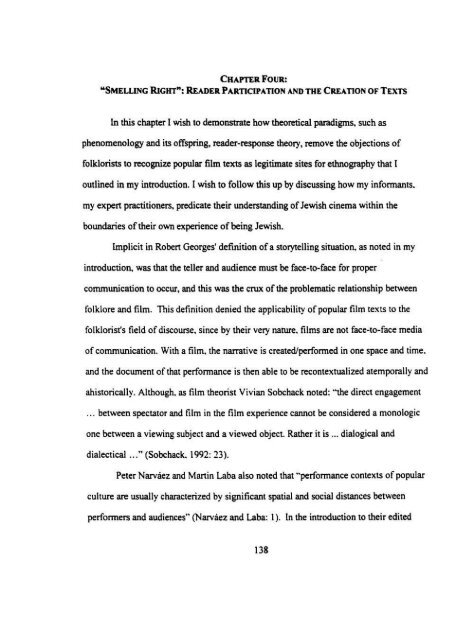Untitled - Memorial University of Newfoundland
Untitled - Memorial University of Newfoundland
Untitled - Memorial University of Newfoundland
You also want an ePaper? Increase the reach of your titles
YUMPU automatically turns print PDFs into web optimized ePapers that Google loves.
CHAPTER FOUR:<br />
"SMELLING RIGHT": READER PARTICIPATION AND THE CREATION OF TEXTS<br />
In this chapter I wish to demonstrate bow theomical paradigms, such as<br />
phenomenology and its <strong>of</strong>fspring, reader·response theory, remove the objections <strong>of</strong><br />
folklorists to recognize popular film texts as legitimate sites for ethnography that I<br />
outlined in my introduction. I wish to follow this up by discussing how my infonnanls.<br />
my expert practitioners. predicate their understanding <strong>of</strong>Jewish cinema within the<br />
boundaries <strong>of</strong>their own experience <strong>of</strong> being Jewish.<br />
Implicit in Robert Georges' definition <strong>of</strong>a storytelling situation. as noted in my<br />
introduction. was that lhe leller and audience must be face·to-face for proper<br />
communication to occur, and this was the crux <strong>of</strong>the problematic relationship between<br />
folklore and film. This definition denied the applicability <strong>of</strong> popular film texlS to the<br />
folklorist's field <strong>of</strong> discourse. since by lheir very nalUrt. films are not face-ta-face media<br />
<strong>of</strong> communication. Wilh a film. the narrative is created/performed in one space and time.<br />
and the document <strong>of</strong>lhal performance is then able to be reconlextualized atemporally and<br />
ahislorically. Although. as film theorist Vivian Sobchack noted: "the direct engagemenl<br />
... between spectator and film in the film experience cannot be considered a monologic<br />
one between a viewing subject and a viewed object. Rather it is .. dialogical and<br />
dialectical ..... (Sobchack. 1992: 23).<br />
Peter Narvaez and Manin Laba also noted that "perfonnance contexts <strong>of</strong> popular<br />
culture are usually characterized by significanl spatial and social distances between<br />
perfonners and audiences" (Narvaez and Laba: I). In the introduction to their edited<br />
138

















